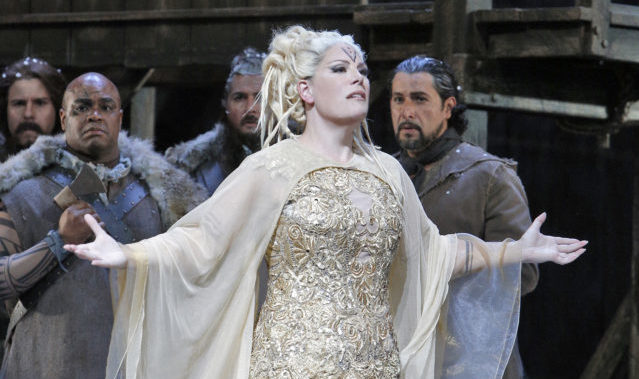On one occasion when Maria Callas was asked which was her favorite operatic role, she said she had two — Violetta, from Verdi’s “La traviata” and the title role from Bellini’s “Norma.” When you think about it, it is hard to imagine two more dramatically and psychologically different characters — the emotionally vulnerable and sickly Violetta, forced to be what she is by the callous “man’s world” that is Paris, and Norma, the super-powerful Druid priestess, who can decide peace or war for her people, and life or death for her subordinate priestesses. It is indicative of the soprano’s legendary musical and dramatic range that Callas would name two such roles as favorites.
It is appropriate to kick off our discussion of Bellini’s opera with a reference to Callas because Chicago was the scene for her American debut as Norma in the Lyric Opera’s inaugural season in 1954. Fast-forward to the 2016-17 season and Lyric is once more staging this beloved Bel Canto opera.
Librettist Felice Romani, as usual, seized upon the idea of “Norma” as a subject for composer Vincenzo Bellini for La Scala in Milan (premièred December 26, 1831). This turned out to be one of Romani’s most inspired flashes ever, seeing that the overwhelming number of librettos he penned are long forgotten. Of course that’s not all his fault. Most of the music composed to his texts, by composers who are rarely if ever listened to, has certainly not stood the test of time. And in those days, well before Tom Edison’s phonograph, Italian opera was extremely popular and there was a tremendous demand for new pieces constantly. And because librettists earned but a fraction of what composers made for a single work, it behooved poets like Romani to churn out librettos as fast as they could.
The dramatic backdrop for “Norma” is the Roman occupation of a certain part of Gaul that is populated by Druids. There is some substance to this as the very earliest historical mention of the Druids is from Julius Caesar’s account of his conquests of Gaul. Caesar also notes that the most influential and powerful members of Druid society were of the religious class — but men, not women.
Norma as a kind of super-woman gets introduced into and mixed up in the Druid story starting not with a Gallic legend, but a Greek myth, that of Medea. She was the priestess/witch who helped Jason steal the Golden Fleece, bore him two sons, and then was so outrageously ditched by him that she cut the throats of her two children. (Arguably the most convincing Norma of the 20th century, Callas added to her fame by reviving Cherubini’s 1797 “Medea” a number of times.) Norma also begins to take shape from an account by another Roman, Tacitus, who writes of a priestess in Germania named Valléda that preached rebellion against Rome. Here is where a dead tree called “Irminsul,” sacred to the Druids in “Norma,” and around which they congregate in the opera, was actually located. (The original “Irminsuls” were pillars, often massive trees, that were symbolic of a mighty pagan god named Irmin.)
Romani was familiar with all these stories. In fact he had written a libretto for J. S. Mayr’s opera, “Medea in Corinto” in 1813 and one for G. Pacini, “La sacerdotess d’Irminsul,” in 1821. What sparked Romani’s choice for the La Scala project was the success of Alexandre Soumet’s successful staging of his 1831 play “Norma” in Paris. For one thing, a theatrical work that made good in the European artistic capital was definitely an attractive subject. Also appealing was that Soumet had gathered together all the disparate tales from Medea to the most recent Irminsul legend in the time of Charlemagne (about 800 AD) and wove them into a gripping drama with its focus on an ultra-strong woman.
Now, this is critically important to understanding Romantic opera. At the time Bellini and Romani were plying their craft, the prima donnas were the most important members of the opera cast. Even beyond the Bel Canto era, well into the Verdi and Puccini years, the musical and dramatic spotlight is trained on the female roles. But in the early 19th century — forget about it! For thousands of years women had been forbidden to sing or act on the Western stage, but now that they were doing so, the novelty was absolutely overpowering! And any composer/librettist team that wanted to do business had no choice but to accommodate public taste. Could you think then, of a better subject than “Norma?”
Thus, despite Caesar’s observations that the prime movers and shakers of the Druids were men, in the opera it is a woman who has the biggest say. This idea somewhat dovetails with a significant stream of 19th century scholarship that held that many pre-historic societies were matriarchies, where men were subservient to women, instead of the other way around, as it has been throughout recorded history. Central to this logic is that the earth is feminine and the sky is masculine, and earlier peoples worshiped Gaia the earth goddess before they started worshiping heavenly gods like Zeus and Jehovah and … well, you get the idea. (How the “Casta diva,” Norma’s most beautiful aria sung to the Moon Goddess fits in with this is beyond me!) The problem is, when any evidence is dug up somewhere, it consistently confirms that men were in charge.
But in this celebrated opera, from the beginning until the very end, it is Norma who is totally omnipotent over her people. Perhaps what makes her such an ultra-forceful character are her incredibly dramatic initial entrance and final exit. There is no other prima donna I can think of that comes in and goes out as dramatically as Norma. Tosca is right there with the exit, but Norma’s is truly remarkable.
The prima donna’s entrance and magnificent standard multi-movement aria “Casta diva” is delayed purposely by Romani and Bellini to build up audience anticipation. This buildup is stressed more than usual, as the text of all the numbers that precede Norma’s entrance refer to her in some way. The Druids want to know whether she will give the go-ahead for rebellion, while the Pollione scene informs us of the existence of Norma’s children and that her love is lost. Before she actually enters there is even a short march. (It’s not John Philip Sousa or even Mozart, but sometimes it finds its way into a concert hall program.) When the high priestess does finally appear, it is a drawn out entrance worthy of Wagner and she is absolutely the center of attention, as all eyes are on her and every ear bends to hear what she has to say.
Norma’s final exit is much quicker. After admitting to disgracing her position as priestess by having an illicit affair with a Roman (of all people!) she happily and courageously goes to her death by jumping into a fire.
Between these starting and finishing points there’s a lot of great music and drama to take in. Let’s look at two scenes for now. Norma does have a Medea moment when she almost cuts the throats of her children out of vengeance for Pollione’s playing around with another, younger priestess. And how does she find out about this waywardness? In what I believe to be the most embarrassing episode in all of opera!
The latest object of Pollione’s attention, Adalgisa, a young Druid priestess, goes to Norma and confesses that she has guilty feelings for a man. Norma, who has her own guilty history with a man, comforts the girl. As they sing a gorgeous Bellini duet, Adalgisa tells Norma some of the love-talk that Pollione has spoken to her. At each mention of the love-talk, in an aside Norma recollects that Pollione said the same things to her. Finally Norma asks Adalgisa just who the man is, and right on cue Pollione enters and sees the two women together and they see him. He is utterly flabbergasted. The impact on the audience is intensely visceral. Bellini never came close to a moment like this again.
Naturally there’s much more to explore in Bellini’s greatest opera. We’ll touch on some of its other fine numbers in a February performance review. And by the way, Lyric has one heck of a Norma leading the cast, soprano Sondra Radvanovsky, truly one of the world’s greatest singers. I can hardly wait!
LYRIC OPERA OF CHICAGO’S “NORMA” 2016-17
Norma — Sondra Radvanovsky
Adalgisa — Elizabeth DeShong
Pollione — Russell Thomas
Oroveso — Andrea Silvestrelli
Conductor — Riccardo Frizz
Director — Kevin Newbury
Set Designer — David Korins
PERFORMANCE DATES
January and 28 February 1, 5, 9, 13, 18, 24
For tickets or more info, visit www.lyricopera.org or call 312-827-5600.
 Fra Noi Embrace Your Inner Italian
Fra Noi Embrace Your Inner Italian






